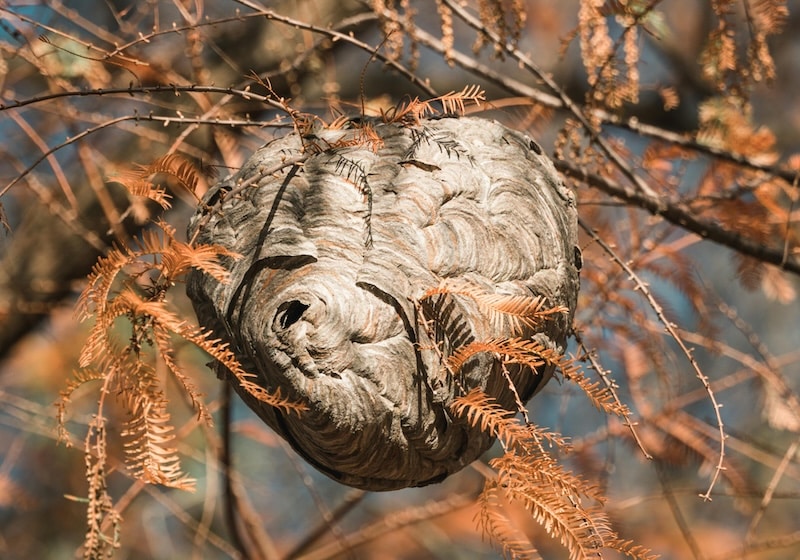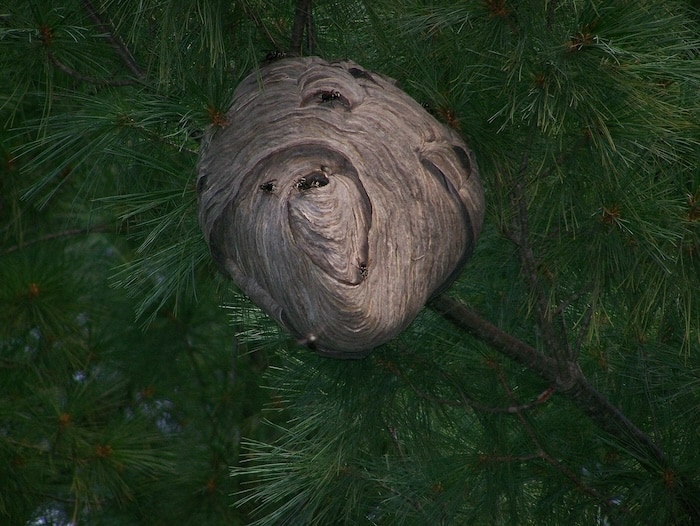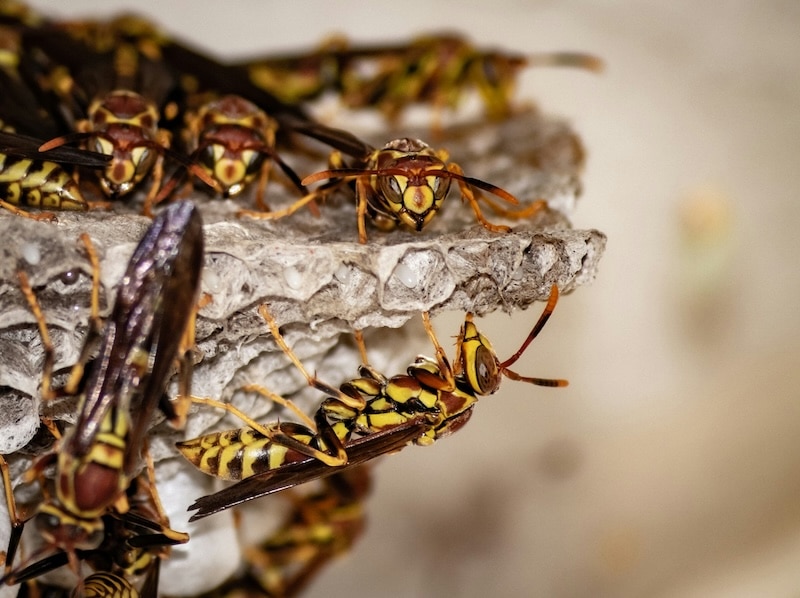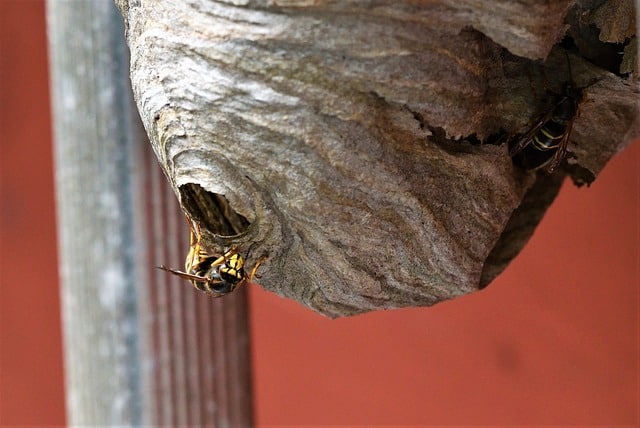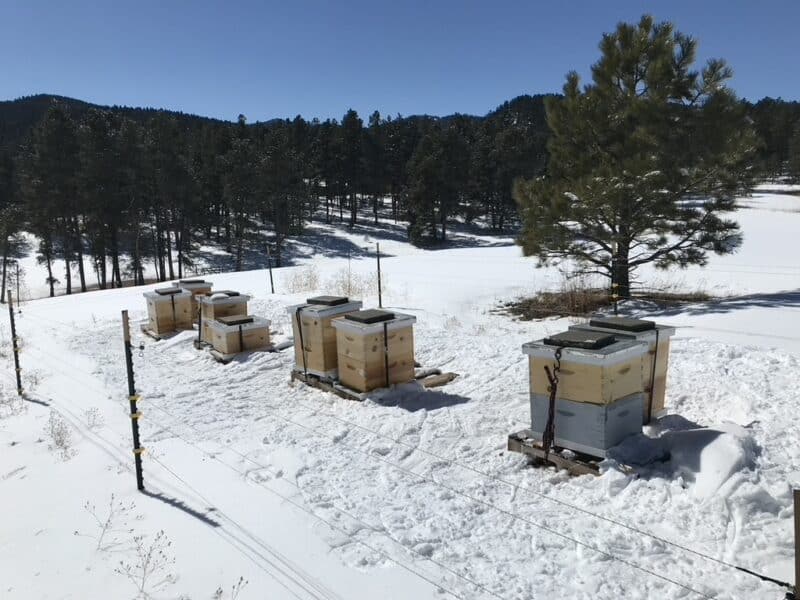Contents:
- Social wasp vs solitary wasp nests
- Types of wasps nests and how they’re constructed
- How to identify a wasp nest
- What type of nest is it?
- Wasp nest prevention & removal
- What does a wasp nest look like?
- FAQs
If you’ve had the unfortunate luck of stepping on a nest or being stung by a smooth-bodied black and yellow pollinator, did you know that you likely encountered a wasp, and not a bee?
Although wasps and bees are evolutionary cousins, there are still many ways to distinguish between these two pollinators. A bee like an Italian honey bee uses pollen as a protein source and nectar as a carbohydrate, making them a vegan pollinator, whereas wasps rely on meat for protein. The primary role of a wasp is not only pollination, but also biological control — as predators, they can become very helpful in gardens because they will eat pests that tend to feed on crops.
–– Interested to know how the bees are doing? Download our State of the Honey Bee Report now ––
Like all pollinators, wasps and bees build nests to protect their queen, her eggs, and the larvae — but the nests themselves are vastly different. Continue reading for a deep-dive into wasp nests, how you can identify one, and what you should do if you see a wasp nest near your home.
Social wasps vs solitary wasps nests

Scientifically, social insects are defined as having an overlap of generations, cooperative care of the brood (babies), and reproductive division of labor (typically called queens and workers). A solitary insect is the exact opposite, in which the insects live by themselves and don’t interact with or rely on others to survive.
According to Dr. Noah Wilson-Rich, Co-Founder of The Best Bees Company, many solitary wasps and bees make their nests underground, excavating a hole within which they will raise their young. There are similarities in the nesting and foraging habits of solitary wasps and bees, but the differences truly lie in their behavior and biochemistry. However, the same cannot be said for solitary and social wasps, as their nesting behavior differs depending on its sociality.
Types of wasps nests and how they’re constructed
Considering the fact that there are an estimated 30,000 identified species of wasps according to National Geographic, there is no question that the types of nesting for this specific pollinator can vary, depending on the location, climate, and species of wasp.
Paper wasp nest

Paper wasps are social wasps that commonly feed on insect pests in gardens, making them a beneficial pollinator to have nearby. Their name is closely related to their nest, as paper wasps actually make their nests out of paper!
According to Wilson-Rich, paper wasps will make their nests by a process called maceration, or by chewing the fibers of wood, bark, and cloth. By doing so, the raw material breaks down and forms a paper-like product that they use for their umbrella-shaped nests in protected locations like on tree branches, in attics, on door frames, or even in shrubs.
Hornet nest
Hornets, the largest of the social wasps, make their nests similarly to the paper wasps. They also create nests out of the paper-like product of maceration. However, hornet nests are, fittingly, larger than those of paper wasps.
Additionally, another key difference between paper wasp nests and hornet nests is the structure of the hive’s entrance. Hornet nests are structured in what is known as closed architecture. The hornet nest is surrounded by an envelope, an outer layer, that only has one small opening at the bottom of the nest.
Mud wasp nest

Also referred to as a “mud dauber”, a mud wasp constructs its nest out of mud and can often be found on sides of buildings or bridges. A mud wasp is also a solitary wasp, which means that there is one wasp building a single nest and calling it home. These nests are constructed with mud or clay, in addition to the saliva of the insect and these materials are formed into a tube-like structure. According to the Missouri Department of Conservation, a female mud dauber will carry “mud balls from a puddle to the nest site, and a cell takes about an hour to construct.”
Ground nest
Various solitary insects like digger wasps will dig a tunnel in the ground to make their home and to lay eggs. According to Wilson-Rich, these wasps will dig a hole into the ground individually, and it is the female that creates this nest. These wasps are not easily found since only the opening is visible and not the nest itself.
How to identify a wasp nest
Over the winter, wasps will shelter in a state of dormancy in warm areas called hibernacula, which can be the attic of a human house, or in the hole of a tree that provides protection from the environment. Once the spring comes, they will then return to their original home area to build a new nest.
Identifying a wasp nest can be accomplished by understanding the species, your location, and its behavior. A hornet nest is composed of hexagonal cells (similar to the honeybee), but it is surrounded by that aforementioned outer shell of a gray paper-like material, with an opening at the bottom for the wasps to enter and leave.
Paper wasp nests, on the other hand, have entrances that are structured in an open architecture style. The paper wasp nest may have an outer layer, but the bottom of the nest is open enough to see its interior — the hexagonal cells are on display, whereas they are hidden in a hornet nest.
While it is difficult to see a full nest that is underground, a sure-fire way to understand if you’ve stumbled upon a wasp nest is to know the difference between this pollinator and others, like the honey bee. An Italian honey bee has a shorter body with fuzz, and a wasp like yellowjackets or hornets will have a smooth, longer, black and yellow body, with a very thin waist. Paper wasps can also be recognized by the fact that they fly with their back legs hanging down.
If you’ve encountered multiple wasp nests in one area, you may be witnessing a biological term called Natal Philopatry. According to Wilson-Rich, this is used to explain the concept of genetic families returning to where they were from.
“With wasps in particular, the nest itself has hydrocarbons, which is a scent. When the wasp itself is born, it does not have a scent but over time, the hydrocarbons from the wasp nest transfer onto the cuticle (skin) of the wasp permanently. This helps them come back to the original location of their old nest — they can recognize the scent of their home.”
Although it is possible for wasps to return to the same location of a previous hive, it’s important to note that wasps will never reuse a nest after one season.
What type of nest is it?
| Hornet’s Nest | Paper Wasp’s Nest | Mud Wasp Nest | |
| Size | Average size of a basketball, sometimes larger | 6-8 inches, hexagonal designer | 2 inches wide, 4-6 inches long, long tubular design |
| Material | Paper-like material made from chewed wood fibers and saliva | Paper-like material made from chewed wood fibers and salvia | Mud or clay mixed with spit |
| Colony Size | 100-700 workers plus a queen | 20-30 insects | 1 wasp per nest |
| Location | Tree branches, eaves, shrubs | Eaves, branches, pipes, or any sheltered area | Eaves, covered area, porches |
Source: a-z-animals.com
Wasp Nest Prevention & Removal
Many of us feel fear when we see a wasp nest, but instead of panicking or trying to remove the nest yourself, Wilson-Rich has a different approach. When you first come across a wasp nest, take a breath and try to be curious about the nest itself and ask yourself a few questions — is it enveloped by an outer paper shell? Can you see inside to the inner hexagonal structures? Can you see wasps inside, and are their back legs hanging down if they’re flying? What color is the hive?
All of these questions can help you tap into the curiosity and awe we all intrinsically feel towards nature — from the time we are children observing a butterfly, to adults marveling at a beautiful sunset. If you stop to take a moment and allow yourself to be curious instead of afraid, you can observe the species of the wasps and recognize that you’ve actually fostered an environment that supports native pollinators, which is something to be very proud of.
Wilson-Rich says, “Even if you have to end up removing the nest because its location is dangerous, taking that moment to appreciate the complexities of the natural world, and being curious about the world around you, can connect you in a deeper way to the experience of life on this extraordinary planet.”
When it comes to wasp nest prevention, we know that wasps can return to the places where they have come from and that they are driven by scents, similar to how bees are driven by pheromones. One way to prevent a wasp nest from returning to its first location is to knock down the nest during the early spring before these wasps return, and then thoroughly clean the area where the nest was.
While calling a beekeeper is always the safest option, this nest can also be removed by using a ladder, a spatula, and a trash bag. By removing this unused nest, you will minimize the likelihood of the wasps returning to that location and instead encourage them to look elsewhere. There has also been an influx of “wasp nest decoys” available for sale on various websites, but entomologist Nancy Miorelli notes that wasps are likely undeterred by false or decoy nests.
What does a wasp nest look like?
Hornet nests are made of a paper-like product, typically in varying shades of grey and brown. They are enveloped by a solid outer layer of paper that is wrapped around the entirety of the hive, except for a small opening at the bottom. Paper wasp nests look almost like an umbrella opened upside down, with the hexagonal cells of the nest — constructed out of the same paper-like material as the hornet nest — clearly displayed. Mud wasp nests are tubular in design, made of dried mud or clay. Multiple mud wasp nests in a row may resemble a strange set of clay organ pipes. Wasp nests in the ground, such as yellowjacket nests, are only visible as a small hole in the dirt.
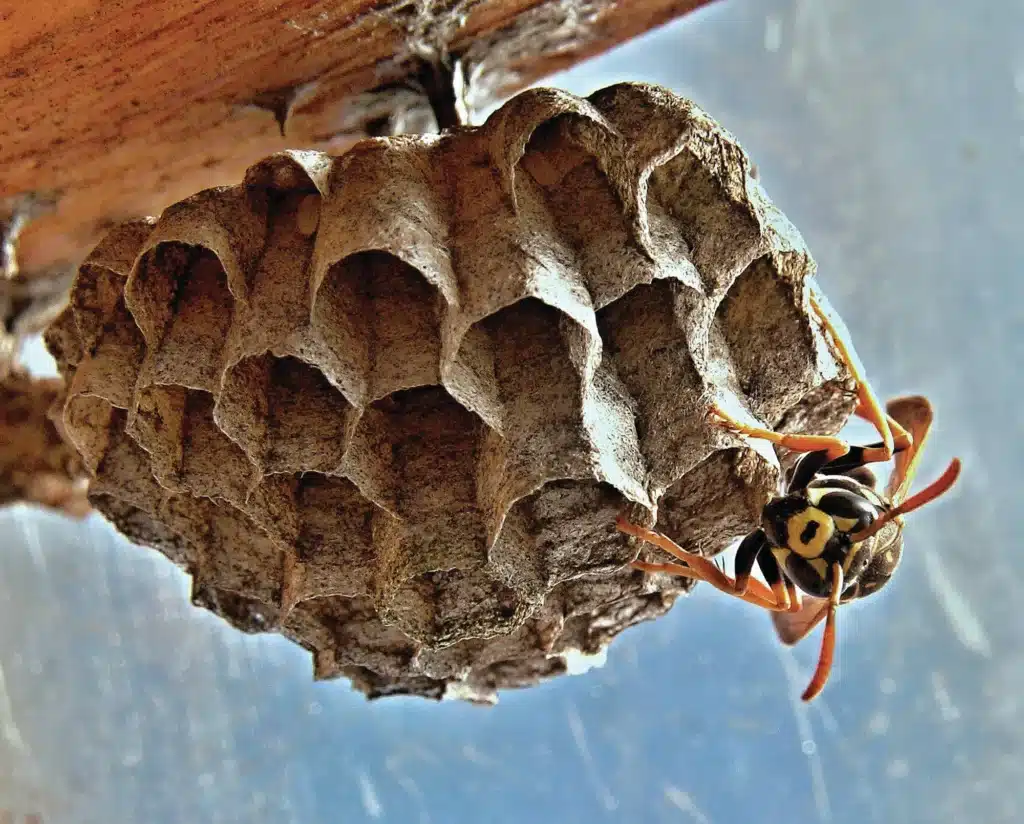

FAQ’s
Q: Are wasp nests dangerous?
A: While wasp nests are not intentionally dangerous, wasps can sting if they are threatened. It is recommended that wasp nests be left alone if found near a home or building.
Q: How long do wasps nests last?
A: Wasp nests will typically last one season, but it is dependent on the weather where this hive is located.
Q: What types of wasp nests are there?
A: Wasps typically nest underground by digging holes, but can also be found hanging on trees or under door frames by a paper-like structure with a hole at the bottom.
Q: Do wasp nest decoys work?
A: While there has been an increased amount of false or decoy wasp nests available for purchase in order to deter wasps from making a nest in a certain area, entomologists note that these fake nests likely do not deter wasps at all.


